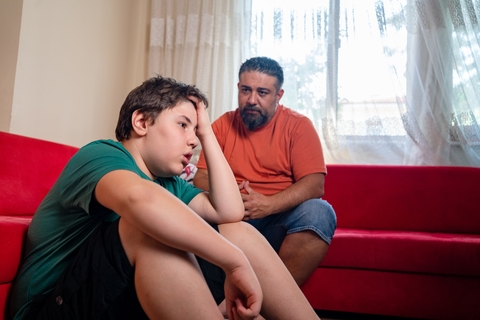If you or someone you love is having thoughts of suicide, please contact:
National Suicide Prevention Lifeline - Call or text 988.
When suicide touches your community
When someone in your community attempts or completes suicide, everyone can be affected. Young people in particular can have strong feelings and may need your help understanding them. If you find yourself having to explain suicide to a young person, you may be wondering how to start the conversation. Try these practical tips and conversation starters for parents, educators and other caring adults when talking with youth about suicide.
Suggestions for approaching the conversation
Ask about what they know.
Before you begin to explain the situation, ask the young person what they already know and build from that.
Tell the truth.
Telling a young person that someone they know or love has died by suicide can be daunting. While difficult, it is best to tell the truth to avoid confusion and misinformation. Research shows that talking about suicide does not increase the risk of suicide. You might start by saying, “I have some difficult news to share. X died and I’m very sad.” Assure them that “I am here to answer any questions you have. I may not always have all of the answers, but I will always do my best to be honest and share with you what I do know.”
Words matter. Use the words “died by suicide”, “took their life”, or “attempted to end their life” rather than “committed suicide” (which has criminal overtones). When talking with young people, avoid detailed descriptions of the person’s situation and the method of suicide, and emphasize that help is available.
Speak in age appropriate ways.
Young people need the same basic facts but with different levels of complexity. Whatever the age, use language they will understand.
Young children need brief, simple information balanced with reassurance. Stick to the basics and say, “They died by suicide, which means they killed themself.” Let the child lead the conversation, and encourage any and all questions and feelings. Do not give graphic details or talk at length about the specific method of suicide. Focus instead on how to cope with feelings of sadness, loss and anger.
Pre-teens will want more concrete information. Start by asking them what they have heard about the person or about suicide. This allows you to correct misinformation and begin the conversation at the young person’s level of understanding. If asked why, you might say, “They had a disease called depression which made them feel very sad and hopeless. Because of the disease they could not think clearly like we do, so they could not think of any other way to get help or to end their pain.” Let them know that mental illnesses are treatable in most cases, but for some, they can be fatal. If asked how, give basic facts but not a lot of detail. “They used [a gun/pills] which made their body stop working and then they died.”
Teens have likely been exposed to suicide, whether they’ve seen it on TV, heard about it at school, known someone who struggled with it, or had suicidal thoughts themselves. The older they are, the more direct you need to be: “Because they felt hopeless and weren’t thinking clearly, they weren’t able to think of other ways of seeking help or coping besides suicide.”
Ask, listen, question.
First, ask the young person how they are feeling about the situation and take time to listen. Reassure and comfort them if they are processing difficult emotions. They may need time to take in information, so consider coming back to this again later. “I support you however you feel. I want you to know I’m here to listen whenever you need me.” Encourage questions. Invite the young person to ask you whatever is on their mind. If you don’t have answers you can say “I don’t know” or “I wish I knew - I have lots of questions too.” Don’t feel like you need to have all the answers. You may have as many questions as your child, and that’s okay.
Encourage help-seeking.
As appropriate for the young person, explain that many people seek help from mental health professionals when they learn about a suicide. Emphasize the importance of working through their feelings. “For some people, it’s helpful to talk with a mental health professional about their feelings about suicide. If this might help you, I can help find someone.” If your young person is concerned about a friend, you can say: “This is an important time for our [family, school, team, community] to support and look out for one another. If you are concerned about a friend, you need to be sure to tell a trusted adult.”
Related resources
- Talking to Teens: Suicide Prevention (American Psychological Association)
- Youth Crisis and Education Resources (National Alliance on Mental Illness - Minnesota)
- Talking to Children About a Suicide (Mental Health Commission of Canada)
- Suicide in Children and Teens (American Academy of Child and Adolescent Psychiatry)
- Talking to your Child About Suicide: An Age-by-Age Guide for Parents (University of Utah)
- Talking with your Child About Suicide handout (University of Minnesota Extension)
Reviewed in 2022



